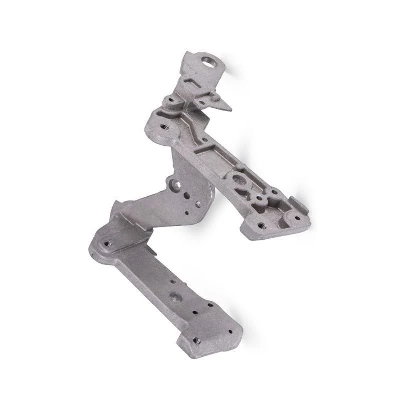Products DescriptionComputer Numerical Control (CNC) Machining
makes the machining process automated. The computer controller
deciphers G-Code and M-Code (written programs) to determine the
tool path for selective material removal. Machining used to be a
manual process which introduced a significant potential for human
error. By making the process computer-controlled, the machining is
more consistent and lends itself well to mass production.SAIVS
specializes in small to medium parts manufacturing, CNC turning,
and CNC milling for the marine, telecommunications, transportation,
and auto industries to name a few. We always ensure that our
customers receive machined components with absolute accuracy and
within critical tolerances. SAIVS is experienced in machining both
ferrous and non-ferrous metals. We have a wide range of machinery
from, horizontal and vertical 4 ax4-axis machining centers, and 3
axis turning centers. Below are more specific details about our
equipment. Item Name: China Metal Casting
Foundry Product Customized Aluminum Die Casting Material:
Aluminum, stainless steel, copper, brass, galvinized etc.
Color: Natural Color Application: CNC MACHINING PARTS
Surface finish:Hard Coating/Black Anodize/Clear Anodize/Hard
Chrome/Clear Zinc/Plasma Niride Size: Customized Size Process:
Turning, Milling, Lathing, Drilling, Honing, Grinding Testing
Equipment: Projector, Pin Gauge, CMM What is die casting?Die
casting is a type of metal casting that uses high pressure to force
molten metal into a mold cavity formed by two dies. It shares
traits with the plastic manufacturing process of injection
molding.Within the larger metal casting landscape, die casting is
one of the most popular techniques due to its accuracy and level of
detail. The broader category of metal casting, which has existed
for thousands of years, contains many different processes that use
a mold to form liquid metal. Historically, such a process usually
involved pouring the liquid metal into the mold with the aid of
gravity - and many metal casting processes still work this way. Die
casting, however, is a relatively new form of metal casting,
introduced in the 19th century, and it uses pressure instead of
gravity to fill the mold cavity.Die casting is sometimes called
high-pressure die casting, due to the amount of pressure -
typically 10-140 megapascals - used to force the metal into the
mold cavity. The related process of low-pressure die casting (LPDC)
is less common. Die casting typically falls into one of two
categories: hot-chamber die casting and cold-chamber die casting,
which are suitable for different types of metal. However, there are
also other variants of the process, such as semi-solid metal
casting (SSM)What kind of material we can do ?Gray Iron: HT150,
HT200, HT250, HT300, HT350; GJL-100, GJL-150, GJL-200, GJL-250,
GJL-300, GJL-350; GG10~GG40. Ductile Iron orNodular Iron: GGG40,
GGG50, GGG60, GGG70, GGG80; GJS-400-18, GJS-40-15, GJS-450-10,
GJS-500-7, GJS-600-3, GJS-700-2, GJS-800-2;QT400-18, QT450-10,
QT500-7, QT600-3, QT700-2, QT800-2;How die casting worksIn simple
terms, metal die casting works by using high pressure to force
molten metal into a mold cavity, which is formed by two hardened
steel dies. Once the cavity is filled, the molten metal cools and
solidifies, and the dies open up so the parts can be removed. In
practice, however, there are many steps in the process, and skilled
engineers are required to operate die casting equipment.Here we
will divide the die casting process into three
stages:MoldmakingCastingPost-machiningQuality Control1) Checking
the raw material after they reach our factory------- Incoming
quality control ( IQC)
2) Checking the details before the production
line operated
3) Have a full inspection and routing
inspection during mass production---In-process quality
control(IPQC)
4)
Checking the goods after they are finished---- Final quality
control(FQC)
5) Checking the goods after they are finished-----Outgoing
quality control(OQC)Die casting applicationsDie casting is a
powerful, versatile process suitable for a range of parts, from
engine components to electronics housings. Reasons for the
versatility of die casting include its large build area, range of
material options, and ability to make detailed, repeatable,
thin-walled parts.Automotive: Aluminum die casting is popular in
the automotive industry as it can produce lightweight components
like hydraulic cylinders, engine brackets, and gearbox cases. Zinc
die casting is suitable for fuel, brake, and power steering
components, while magnesium die casting works for panels and seat
frames.Aerospace: As in the automotive industry, aerospace parts
suppliers use aluminum die casting to make lightweight parts that
exhibit a high level of heat and corrosion resistan
Related products about China Factory Price High Quality Anodizing Aluminum Die Casting Forging Parts
-
 Waste Tyre Plastic Recycling Machinery Machine Tire Crusher Production Line Rubber Crumb Grinding Machine Equipment Tire Shredder
Waste Tyre Plastic Recycling Machinery Machine Tire Crusher Production Line Rubber Crumb Grinding Machine Equipment Tire Shredder
-
 Stretch Plastic Blowing Pet Bottle Making Blow Molding Machine Bottles Stretch Automatic Pet Bottle Blowing Machine
Stretch Plastic Blowing Pet Bottle Making Blow Molding Machine Bottles Stretch Automatic Pet Bottle Blowing Machine
-
 Waste Plastic Pet Bottle, Water Bottle Flake, PP/HDPE/LDPE PE Film Jumbo Woven Bags Plastic Crusher Machine, Plastic Crushing Washing Recycling Machine
Waste Plastic Pet Bottle, Water Bottle Flake, PP/HDPE/LDPE PE Film Jumbo Woven Bags Plastic Crusher Machine, Plastic Crushing Washing Recycling Machine
-
 Type 2 Wall-Mounted Electric Car Charging Station 7kw /11 Kwelectric Vehicle Charging Station Home Wallbox AC EV Charger Single Phase or 3three Phase
Type 2 Wall-Mounted Electric Car Charging Station 7kw /11 Kwelectric Vehicle Charging Station Home Wallbox AC EV Charger Single Phase or 3three Phase
-
 G-View G12W Wholesale Auto Car LED Headlight Bulb High Power H13 H11 9005 H7 H4 Car LED Headlights LED Car Lights
G-View G12W Wholesale Auto Car LED Headlight Bulb High Power H13 H11 9005 H7 H4 Car LED Headlights LED Car Lights
-
 New Design Porcelain Round Plates Dinner Set for Wedding and Banquet
New Design Porcelain Round Plates Dinner Set for Wedding and Banquet
-
 China 2023 New Design Super Soft 100% Polyester Microfiber Knitted Oversized Decoration Hoodie Blanket
China 2023 New Design Super Soft 100% Polyester Microfiber Knitted Oversized Decoration Hoodie Blanket
-
 Handmade Art Creative Materials Thickened White Paper Cup DIY Disposable Handmade Colored Paper Cup
Handmade Art Creative Materials Thickened White Paper Cup DIY Disposable Handmade Colored Paper Cup






